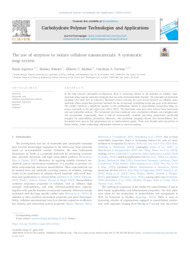The use of enzymes to isolate cellulose nanomaterials: A systematic map review.
The use of enzymes to isolate cellulose nanomaterials: A systematic map review.
Author(s): SQUINCA, P.; BILATTO, S.; BADINO, A. C.; FARINAS, C. S.
Summary: In the shift towards sustainable development, there is increasing interest in the isolation of cellulose nanomaterials using enzyme-mediated strategies that are more environmentally friendly. The principles of systematic mapping were used here to conduct a literature review covering the most recent research on cellulose nanomaterials whose production processes included the use of enzymes, identifying trends and gaps in the literature. results evidenced a significant increase in the publications related to nanocellulose production using enzymes, especially in the last eight years (2013?2021). The feedstocks most used were derived from hardwoods and agro-industrial residues. The commonest enzymes employed were commercial cellulase and endoglucanase rich preparations. Importantly, there is still no commercially available enzymatic preparation specifically designed for nanocellulose production. Moreover, this systematic mapping showed that nanocelluloses have frequently been used in film preparation and as reinforcement agents. These data should assist researchers in future studies, while synthesizing information relevant to decision-making.
Publication year: 2022
Types of publication: Journal article
Unit: Embrapa Instrumentation
Keywords: Cellulose nanomaterials isolation, Systematic map
Observation
Some of Embrapa's publications are published as ePub files. To read them, use or download one of the following free software options to your computer or mobile device. Android: Google Play Books; IOS: iBooks; Windows and Linux: Calibre.
Access other publications
Access the Agricultural Research Database (BDPA) to consult Embrapa's full library collection and records.
Visit Embrapa Bookstore to purchase books and other publications sold by Embrapa.

